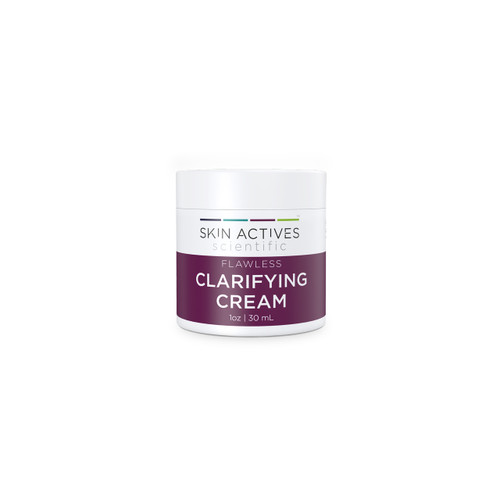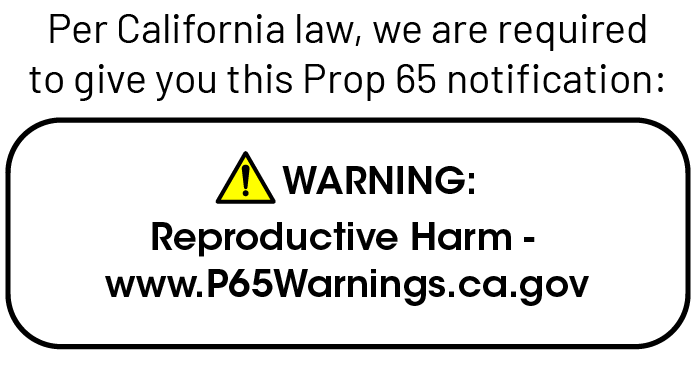For best results, we recommend applying Skin Actives Clarifying Cream at night since it contains Retinyl Acetate, which can make your skin more sensitive to sunlight. After cleansing your face at night, apply a small amount to your face or any other area prone to breakouts and excess oil. Remember to wear sunscreen daily. For maximum results, check out our other Flawless products.
How it works
- Helps control excess oil production
- Helps reduces and clear blemishes
- Calms redness and irritation due to breakouts
- Nourishes and hydrates skin
How to use it
Apply a small amount to clean skin on the face nightly after cleansing. You can also use it on your back or anywhere your blemishes or oil tend to pop up.
Quick Tips
This cream contains Vitamin A, which can increase photosensitivity. Please be sure to wear sunscreen daily.
Ingredients
Water, Seakelp (Lactobacillus/Kelp Ferment Filtrate) Bioferment, Niacinamide, Glycerin, Helanthius Annus (Sunflower) Seed Wax, Sodium Polyacrylate, Simmondsia Chinensis (Jojoba) Oil, Propanediol, Salicin, Rosa Canina (Rosehip) Seed Oil, Raphanus Sativus (Radish) Seed Extract, Pentylene Glycol, Dimethicone, Diosgenin, Dipotassium Glycyrrhizate, Hippophae Rhamnoides (Seabuckthorn) Fruit Oil, Linum Usitatissimum (Linseed) Seed Oil, Docosahexaenoic Acid, Retinyl Acetate, Beta Glucan (Yeast), sr-Honey Bee Defensin-1, sh-Polypeptide-108, Calendula Officinalis Flower Water, Nobiletin, Hydrolyzed Collagen, Sodium Hyaluronate, Fucoidan, Oleanolic Acid, Punica Granatum (Pomegranate) Seed Oil, Tocotrienols, Tocopherols, Astaxanthin, Lycopene, Xanthophyll, Thioctic Acid, Beta-Carotene, Phenoxyethanol, Chlorphenesin, Caprylyl Glycol, Sorbic Acid.
Research
Brown, Gordon D.; Gordon, Siamon (2001) Immune recognition: A new receptor for beta-glucans. Nature (London, United Kingdom) 413: 36-37. Johann, S., de OliveiraV.L., Pizzolatti, M.G., Schripsema, J. Braz-Filho, R. Branco, A., Smânia A. Jr (2007) Antimicrobial activity of wax and hexane extracts from Citrus spp. peels. Memorias Instituto Oswaldo Cruz: 102: 681-685
Fiore Cristina; Eisenhut Michael; Ragazzi Eugenio; Zanchin Giorgio; Armanini Decio (2005) A history of the therapeutic use of liquorice in Europe. Journal of ethnopharmacology, 99: 317-24.
Finney, R. S. H.; Somers, G. F.; Wilkinson, J. H.(1958) Pharmacological properties of glycyrrhetinic acid - a new anti-inflammatory drug. Journal of Pharmacy and Pharmacology, 10: 687-95.
Kawaguchi, Yoshiteru; Goh, Kikyo; Kawa, Yokota T; Nishio H; Kubota Y; Mizoguchi M (1998) The inhibitory effect of glabridin from licorice extracts on melanogenesis and inflammation. Pigment Cell Research, 11:355-61.
Kim, Hyung Keun; Park, Yoonkyung; Kim, Hee Nam; Choi, Bo Hwa; Jeong, Hye Gwang; Lee, Dong Gun; Hahm, Kyung-Soo (2002) Antimicrobial mechanism of glycyrrhetinic acid isolated from licorice, Glycyrrhiza glabra. Biotechnology Letters, 24:1899-1902.
Kollár, R, Reinhold B.B., Petráková, E. , Yeh, H.J.C., Ashwell, G., Drgonová, J., Kapteyn, J.C., Klis, F.M. and Cabib, Enrico (1997) Architecture of the Yeast Cell wall beta (1-->6)-glucan interconnects mannoprotein, beta (1-->3)-glucan, and chitin. Journal Biological Chemistry: 272: 17762-17775. Kougias, Panagiotis; Wei, Duo; Rice, Peter J.; Ensley, Harry E.; Kalbfleisch, John; Williams, David L.; Browder, I. William (2001) Normal human fibroblasts express pattern recognition receptors for fungal (1-->3)-beta-D-glucans. Infection and Immunity: 69: 3933-3938.
Sato T, Takahashi A, Kojima M, Akimoto N., Masamichi Y., and Ito, A. (2007) A citrus polymethoxy flavonoid, nobiletin inhibits sebum production and sebocyte proliferation, and augments sebum excretion in hamsters. J. Inv. Dermatology, 127: 2740-2748 Sulzberger, NB and Zidens, SH. (1948) Psychogenic factors in dermatologic disorders. Med. Clin. North. Am. 32: 669-688.
Tanaka S, Sato T, Akimoto N, Yano M, Ito A (2004) Prevention of UVB-induced photoinflammation and photoaging by a polymethoxy flavonoid, nobiletin, in human keratinocytes in vivo and in vitro Biochemical Pharmacology 68: 433-439
Toyoda, M and Morohashi, M. (2003). New aspects in acne inflammation. Dermatology 206:17-23.









